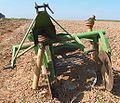Potato harvester
Potato harvesters are specific harvesting machines for potatoes . They are tools that are used in technical agriculture to harvest various tuber vegetables, but above all the potato that gives it its name. They come in different designs and functional principles. Today the shape of the Siebroder dominates .
history
The potato harvesters came up in the mid to late 19th century. They represented a first step in the mechanization of potato growing and were initially implemented in the form of so-called centrifugal orders. Another technical form of harvesting potatoes in earlier times was the potato plow , a special plow for the potato harvest, which lifted the potatoes to the surface by turning the planted dam.
Centrifugal harvester

The British Hanson and Coleman developed the first centrifugal harvester (also known as the potato witch ) in 1852.
The centrifugal harvester clears the potatoes with a flat share that lifts the potato dam slightly and breaks it open, and a subsequent centrifugal star attached at right angles to the share and thus to the direction of the dam. This circles perpendicular to the dam and throws the soil and potato mixture from the dam in a flat layer around 2 to 3 m to the side through the forks or tines attached to it, so that the potato readers can easily find and collect the potato tubers. In order to avoid damaging the tubers, it was important when designing the centrifugal harvesters that the tines of the centrifugal star do not hit the dam but sweep. The drive of the centrifugal star takes place via an angular gear, which is driven by the wheels of the harvester in older models used with horse or tractor pulls, and in later versions by the PTO shaft of the pulling tractor.
Siebroder
The sieve harvester (also called vibrating harvester or chain sieve harvester) lifts one or more potato ridges onto a sieve using a horizontal share . The soil is sieved out and the potatoes are left in a row behind the machine. In some variants of this form of harvesting, the sieve was moved back and forth by means of the PTO shaft as a vibrating sieve. Siebroders can be used not only for harvesting potatoes but also for harvesting root vegetables such as carrots or celery .
Potato harvester
In modern potato harvesters , the potatoes are cleaned, sorted and collected. They are available as self-propelled machines , but mostly pulled by a tractor .
literature
- Horst Eichhorn (Ed.): Landtechnik . 7th edition. Ulmer, Stuttgart 1952/1999, ISBN 3-8001-1086-5 .
- Paul Schweigmann: The agricultural machines and their maintenance . 1st edition. Pfanneberg, Gießen 1955. (Reprinted by Bulldog-Press, Limburg ad Lahn 1993, ISBN 3-9803332-1-3 )
Web links
Individual evidence
- ↑ Use of rotary harvesters behind the tractor
- ↑ Lanz-Roder in a procession
- ↑ Ulrich Sachweh (ed.): The gardener, Volume 3, tree nursery, fruit growing, seed growing, vegetable growing . 2nd Edition. Ulmer, Stuttgart 1986/1989, ISBN 3-8001-1148-9 , p. 49.


